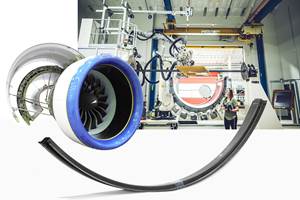Airbus foresees demand for 39,000 new passenger, freighter aircraft by 2040
Retirement of older aircraft to accelerate demand will be progressively driven by replacement, supporting the industry’s decarbonization objectives.
Photo Credit:
In the next 20 years, Airbus (Toulouse, France) forecasts demand for air transport to progressively shift from fleet growth to the accelerated retirement of older, less fuel-efficient aircraft, resulting in a need for some 39,000 new-build passenger and freighter aircraft — 15,250 of these for replacement. As a consequence, by 2040, the vast majority of commercial aircraft in operation will be of the latest generation, up from some 13% today, considerably improving the CO2 efficiency of the world’s commercial aircraft fleets. The economic benefits of aviation extend beyond the sector, contributing around 4% to annual global GDP and sustaining some 90 million jobs worldwide.
This continues from the announcement on May 27, 2021 that Airbus is asking suppliers to prepare for the following aircraft production rates:
- A320 Family: Firm rate of 64/month by Q2 2023 and rate 70 by Q1 2024. Longer term, Airbus is investigating opportunities for rate 75 by 2025.
- A220 Family: Six/month in early 2022 and 14/month by mid-decade.
- A350 Family: Currently at five/month, projected to six/month by autumn 2022.
- A330 Family: Production remains at an average two/month.
While having lost nearly two years of growth during the COVID-19 pandemic, passenger traffic has demonstrated its resilience and is set to reconnect to an annual growth of 3.9%, driven by expanding economies and global commerce including tourism. The middle classes, who are the likeliest to fly, will grow in number by two billion people to 63% of the world’s population. The fastest traffic growth will be in Asia with domestic China becoming the largest market.
The demand for new aircraft will include around 29,700 small aircraft like the A220 and A320 Families, as well as about 5,300 in the medium aircraft category such as the A321XLR and the A330neo. In the large segment, covered by the A350, a need for some 4,000 deliveries is expected by 2040.
Cargo demand, boosted by e-commerce, is driven by an expected growth in express freight of 4.7% per year and a general cargo (representing about 75% of the market) growth of 2.7%. Overall, over the next 20 years, there will be a need for some 2,440 freighters, of which 880 will be new-build.
“As economies and air transport mature, we see demand increasingly driven by replacement rather than growth — replacement being today’s most significant driver for decarbonization,” says Christian Scherer, chief commercial officer and head of Airbus International. “The world is expecting more sustainable flying and this will be made possible in the short term by the introduction of most modern airplanes. Powering these new, efficient aircraft with Sustainable Aviation Fuels (SAF) is the next big lever. We pride ourselves that all our aircraft — the A220, A320neo Family, the A330neo and the A350 — are already certified to fly with a blend of 50% SAF, set to rise to 100% by 2030 - before making ZEROe our next reality from 2035 onwards.”
The global aviation industry has already achieved huge efficiency gains, as shown by the 53% decline in aviation’s global CO2 emissions since 1990. Airbus reports that its product range supports at least a 20% CO2 efficiency gain over previous-generation aircraft. In view of further ongoing innovations, product developments, operational improvements as well as market based options, Airbus asserts it is supporting the air transport sector’s target to reach net-zero carbon emissions by 2050.
Related Content
The potential for thermoplastic composite nacelles
Collins Aerospace draws on global team, decades of experience to demonstrate large, curved AFP and welded structures for the next generation of aircraft.
Read MoreAutomated robotic NDT enhances capabilities for composites
Kineco Kaman Composites India uses a bespoke Fill Accubot ultrasonic testing system to boost inspection efficiency and productivity.
Read MorePlant tour: Collins Aerospace, Riverside, Calif., U.S. and Almere, Netherlands
Composite Tier 1’s long history, acquisition of stamped parts pioneer Dutch Thermoplastic Components, advances roadmap for growth in thermoplastic composite parts.
Read MoreIndustrializing additive manufacturing in the defense/aerospace sector
GA-ASI demonstrates a path forward for the use of additive technologies for composite tooling, flight-qualified parts.
Read MoreRead Next
Scaling up, optimizing the flax fiber composite camper
Greenlander’s Sherpa RV cab, which is largely constructed from flax fiber/bio-epoxy sandwich panels, nears commercial production readiness and next-generation scale-up.
Read MoreCutting 100 pounds, certification time for the X-59 nose cone
Swift Engineering used HyperX software to remove 100 pounds from 38-foot graphite/epoxy cored nose cone for X-59 supersonic aircraft.
Read MoreNext-gen fan blades: Hybrid twin RTM, printed sensors, laser shock disassembly
MORPHO project demonstrates blade with 20% faster RTM cure cycle, uses AI-based monitoring for improved maintenance/life cycle management and proves laser shock disassembly for recycling.
Read More












